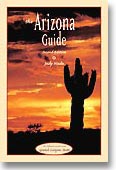 |
||||||||||
 |
||||||||||
 |
||||||||||
 |
||||||||||
|
Search
|
||||||||||
|
Titles |
||||||||||
|
|
||||||||||
|
|
||||||||||||||||||||||||||||||||||||||||||||||||||||||||||||||||
|
|
|
|
Excerpt Tucson
Today’s Tucson is a sophisticated city of about 850,000, a pleasant blend of metropolis and small town that mixes the best of the West with trendy resorts, velvety golf courses, outstanding restaurants and an active arts scene. At an elevation of 2,389 feet, almost 1300 feet higher than Phoenix, it stays a bit cooler than its neighbor to the north. More than 350 days each year are sunny and fair, according to the Tucson Bureau of the U.S. Weather Service. With a metropolitan area covering nearly 500 square miles, the city sprawls north, from a reemerging downtown, toward the picturesque Santa Catalina Mountains, one of five ranges that surround the city. It sits in the eastern portion of the high Sonoran desert, the only place in the world where saguaro cactuses grow naturally. Tucson is flanked by Saguaro National Park East and West where you can see the largest concentration of these “giants with arms” anywhere... Festivals and Events Major Attractions Seeing and Doing Where to Eat Janos Restaurant—$$$$ |
||||||||||
|
Reviews The Arizona Guide is a gold mine of information for anyone exploring our nation´s sixth largest state ... Organized into eight geographic regions, the 324-page book brilliantly captures the multi-faceted personality of a state whose features range from cactus-dotted sands to snow-covered mountains. Wade, one of Arizona´s leading travel writers and a regular contributor to Travel America Magazine, provides inside tips on everything from scenic drives to don´t-miss restaurants. —Travel America Magazine Interesting, informative and handy to have when the mood for a road trip strikes, The Arizona Guide by Judy wade details the what, when, where and how of hiking along the creek in Patagonia, attending the world´s largest gem and mineral show in Quartzsite, trout fishing in Greer and peach-picking in Wickenburg, among other excursions. ... Useful as a personal reference, it also would make a wonderful gift for visitors and friends. —Phoenix Home & Garden The Arizona Guide is very readable and contains information not found in other guides to the state, while also covering every corner of the state. If you travel Arizona for the recreation, the history or the natural world, pick up The Arizona Guide before your next trip. —Ahwatukee Foothills News |
|
Fulcrum Publishing – 16100 Table Mountain Parkway, Suite 300 – Golden, Colorado 80403
|
||
